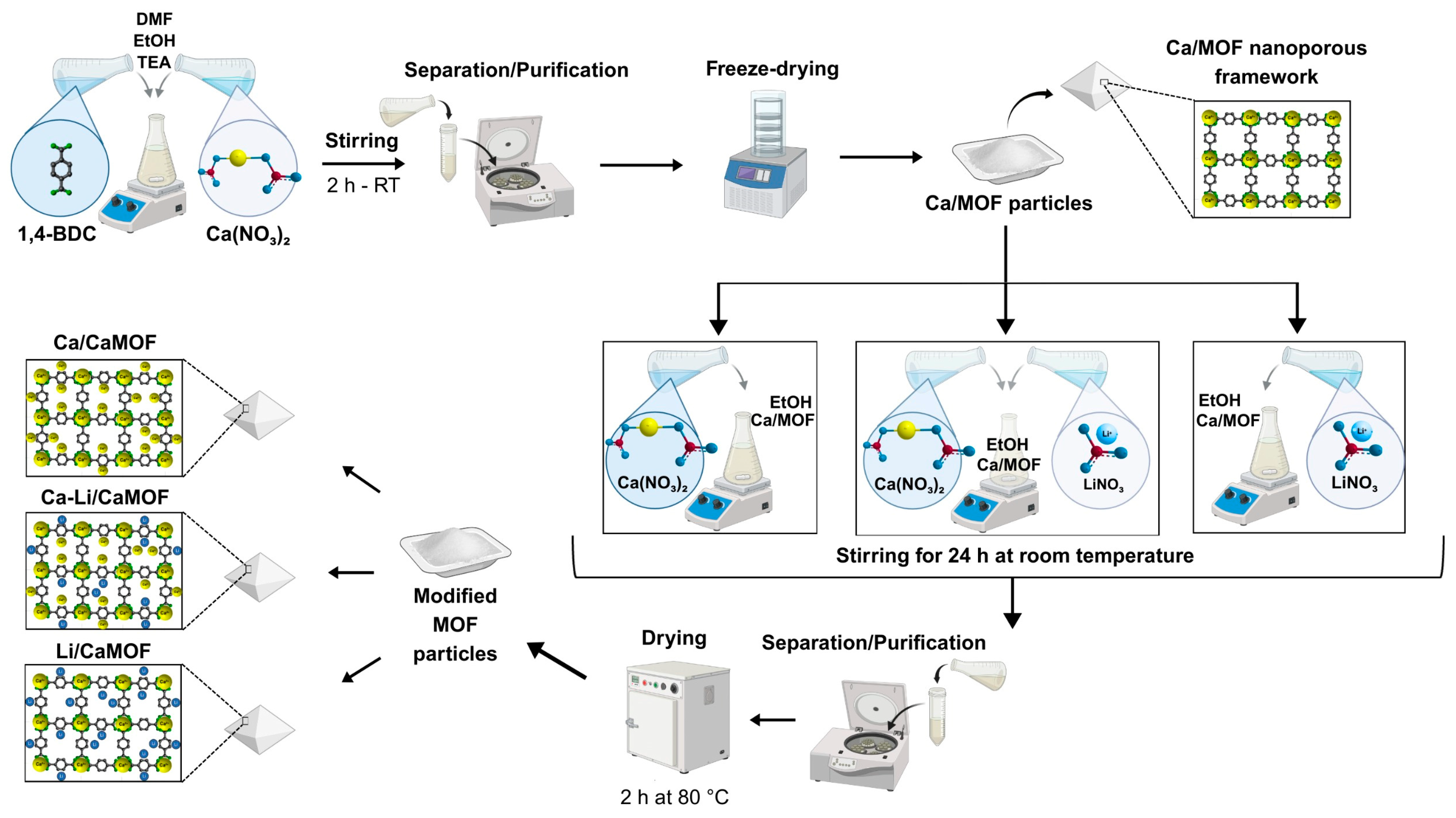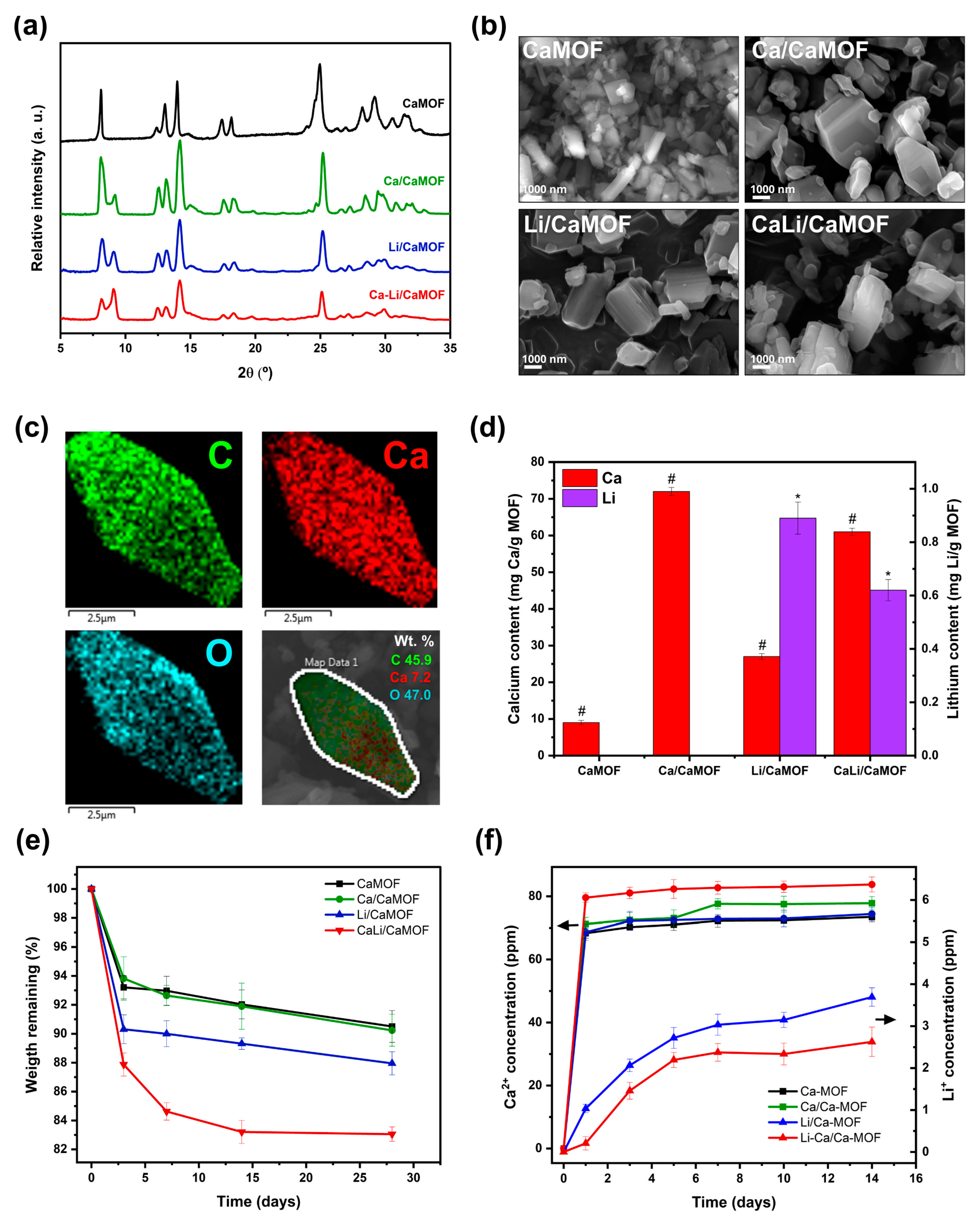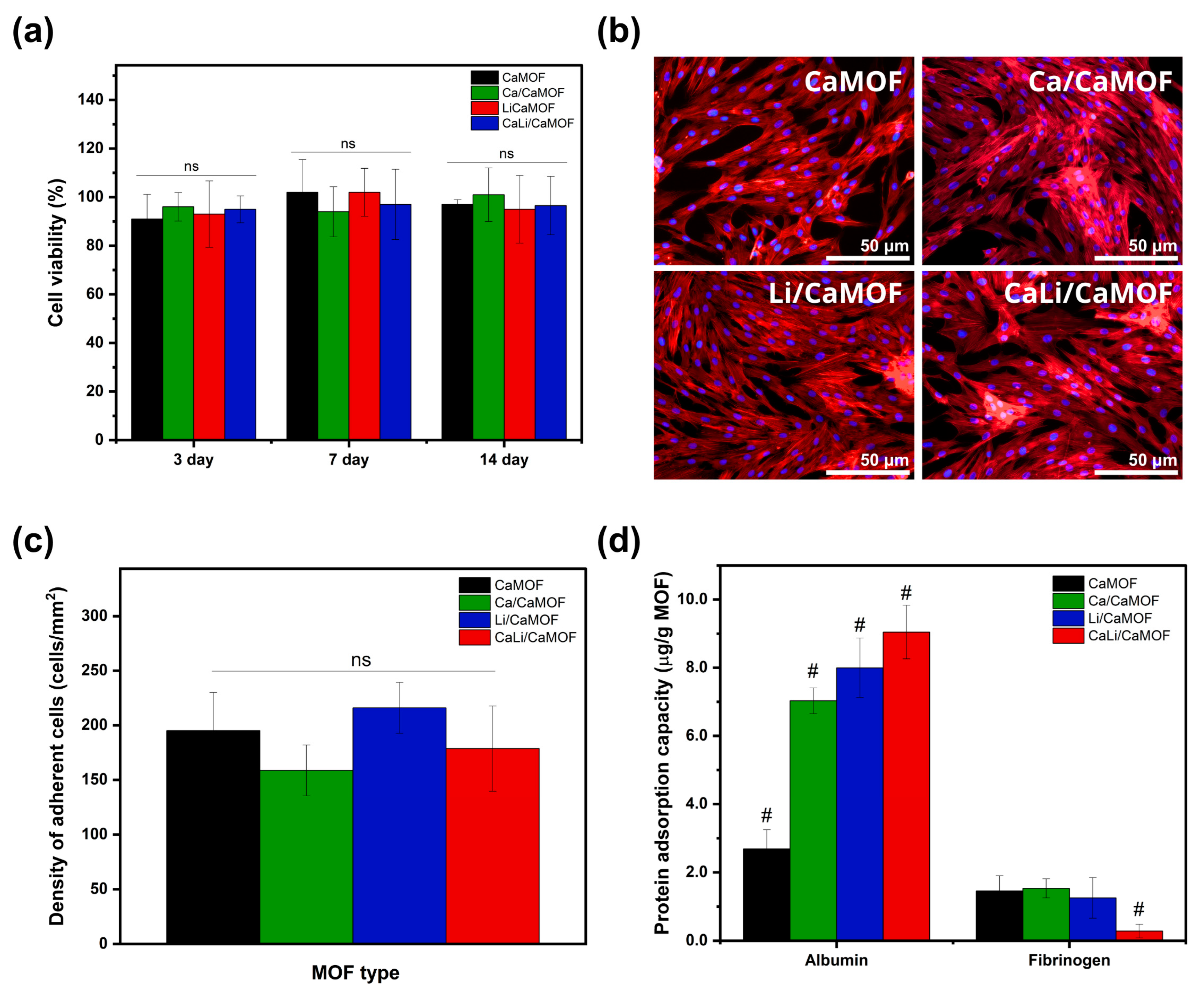Synthesis and Osteoinductive Properties of Nanosized Lithium-Modified Calcium-Organic Frameworks
Abstract
1. Introduction
2. Materials and Methods
2.1. Synthesis of Metal Organic Frameworks (MOFs)
2.2. Structural Characterization of MOFs
2.3. In Vitro Bioactivity Assay
2.4. Protein Adsorption Assay
2.5. MOFs Degradation Test
2.6. Ion Release Measurements
2.7. Cell Culture
2.7.1. Cell Viability Assays
2.7.2. Cell Adhesion Assays
2.7.3. Cell Differentiation Assays
2.8. Statistical Analysis
3. Results and Discussion
3.1. Synthesis and Characterization of MOFs
3.2. In Vitro Apatite—Forming Capacity
3.3. Cytocompatibility
3.4. Cell Differentiation
4. Conclusions
Author Contributions
Funding
Institutional Review Board Statement
Informed Consent Statement
Data Availability Statement
Acknowledgments
Conflicts of Interest
References
- Einhorn, T.; Gerstenfeld, L. Fracture Healing: Mechanisms and Interventions. Nat. Rev. Rheumatol. 2015, 11, 45–54. [Google Scholar] [CrossRef] [PubMed]
- GBD 2019 Fracture Collaborators. Global, Regional, and National Burden of Bone Fractures in 204 Countries and Territories, 1990–2019: A Systematic Analysis from the Global Burden of Disease Study 2019. Lancet Healthy Longev. 2021, 2, e580–e592. [Google Scholar] [CrossRef] [PubMed]
- International Osteoporosis Foundation. Capture the Fracture® Partnership. Available online: https://www.capturethefracture.org (accessed on 1 January 2024).
- Elsalanty, M.E.; Genecov, D.G. Bone Grafts in Craniofacial Surgery. Craniomaxillofac. Trauma Reconstr. 2009, 2, 125–134. [Google Scholar]
- Łuczak, J.W.; Palusińska, M.; Matak, D.; Pietrzak, D.; Nakielski, P.; Lewicki, S.; Grodzik, M.; Szymański, Ł. The Future of Bone Repair: Emerging Technologies and Biomaterials in Bone Regeneration. Int. J. Mol. Sci. 2024, 25, 12766. [Google Scholar] [CrossRef]
- Yusuf, V.F.; Malek, N.I.; Kailasa, S.K. Review on Metal–Organic Framework Classification, Synthetic Approaches, and Influencing Factors: Applications in Energy, Drug Delivery, and Wastewater Treatment. ACS Omega 2022, 7, 43215–43228. [Google Scholar] [CrossRef] [PubMed]
- Hefayathullah, M.; Singh, S.; Ganesan, V.; Maduraiveeran, G. Metal-Organic Frameworks for Biomedical Applications: A Review. Adv. Colloid Interface Sci. 2024, 331, 103210. [Google Scholar] [CrossRef]
- Wu, M.-X.; Yang, Y.-W. Metal–Organic Framework (MOF)-Based Drug Delivery. Glob. Chall. 2023, 7, 2300244. [Google Scholar]
- Gimeno, I.; Luis, F.; Marcuello, C.; Pallarés, M.C.; Lostao, A.; Calero de Ory, M.; Gomez, A.; Granados, D.; Tejedor, I.; Natividad, E.; et al. Localized Nanoscale Formation of Vanadyl Porphyrin 2D MOF Nanosheets and Their Optimal Coupling to Lumped Element Superconducting Resonators. J. Phys. Chem. C 2025, 129, 973–982. [Google Scholar] [CrossRef]
- Shen, X.; Zhang, Y.; Chen, L.; Li, G. Composite Coatings of Mg-MOF74 and Sr-Substituted Hydroxyapatite on Titanium Substrates for Local Antibacterial, Anti-Osteosarcoma, and Pro-Osteogenesis Applications. Mater. Lett. 2019, 241, 18–22. [Google Scholar]
- Chen, M.; Wang, X.; Zhang, Y.; Li, H.; Liu, Z.; Zhao, J.; Sun, W. Nanocatalytic Biofunctional MOF Coating on Titanium Implants Promotes Osteoporotic Bone Regeneration through Cooperative Pro-Osteoblastogenesis MSC Reprogramming. ACS Nano 2022, 16, 15397–15412. [Google Scholar] [CrossRef]
- Li, Z.; Chen, B.; Zhou, M.; Wang, H.; Liu, J.; Zhao, X. Potential Application Development of Sr/HCOOH Metal Organic Framework in Osteoarthritis. Microporous Mesoporous Mater. 2020, 294, 109835. [Google Scholar] [CrossRef]
- Mi, B.; Xiong, Y.; Lin, J.; Zhang, C.; Zhou, W.; Huang, X.; Zhao, C. Metal–Organic Framework-Integrated Composites for Bone Tissue Regeneration. Adv. Funct. Mater. 2023, 34, 2308656. [Google Scholar] [CrossRef]
- Zhao, C.; Liu, Y.; Zhang, Y.; Huang, Z.; Sun, H.; Zhou, X.; Wang, P. Metal-Organic Frameworks Functionalized Biomaterials for Promoting Bone Repair. Mater. Today Bio 2023, 21, 100717. [Google Scholar] [CrossRef] [PubMed]
- Joseph, N.; Sharma, R.; Kumar, P.; Roy, S.; Singh, R.; Das, M. Synthesis and Characterization of CaSr-Metal Organic Frameworks for Biodegradable Orthopedic Applications. Sci. Rep. 2019, 9, 13024. [Google Scholar] [CrossRef]
- Chen, K.; Wang, Y.; Tang, H.; Niu, X.; Yang, H.; Bai, Y.; Gu, X.; Zheng, Y. Fabrication of a Nanoscale Magnesium/Copper Metal-Organic Framework on Zn-Based Guided Bone Generation Membranes for Enhancing Osteogenesis, Angiogenesis, and Bacteriostasis Properties. ACS Appl. Mater. Interfaces 2024, 16, 5648–5665. [Google Scholar] [CrossRef] [PubMed]
- Zhu, Z.; Yin, J.; Guan, J.; Hu, B.; Niu, X.; Jin, D. Lithium Stimulates Human Bone Marrow Derived Mesenchymal Stem Cell Proliferation through GSK-3β-Dependent β-Catenin/Wnt Pathway Activation. FEBS J. 2014, 281, 5371–5389. [Google Scholar] [CrossRef]
- Jin, Y.; Xu, L.; Hu, X.; Liao, S.; Pathak, J.L.; Liu, J. Lithium Chloride Enhances Bone Regeneration and Implant Osseointegration in Osteoporotic Conditions. J. Bone Miner. Metab. 2017, 35, 497–503. [Google Scholar] [CrossRef]
- An, Y.; Lv, X.; Jiang, W.; Wang, L.; Shi, Y.; Hang, X.; Pang, H. The Stability of MOFs in Aqueous Solutions—Research Progress and Prospects. Green Chem. Eng. 2024, 5, 187–204. [Google Scholar] [CrossRef]
- Oyane, A.; Kim, H.; Furuya, T.; Kokubo, T.; Miyazaki, T.; Nakamura, T. Preparation and Assessment of Revised Simulated Body Fluids. J. Biomed. Mater. Res. A 2002, 65, 188–195. [Google Scholar] [CrossRef]
- Mazaj, M.; Kaučič, V.; Logar, N.Z. Spectroscopic Studies of Structural Dynamics Induced by Heating and Hydration: A Case of Calcium-Terephthalate Metal−Organic Framework. J. Phys. Chem. C 2013, 117, 7552–7564. [Google Scholar] [CrossRef]
- Liang, P.-C.; Liu, H.-K.; Yeh, C.-T.; Lin, C.-H.; Zima, V. Supramolecular Assembly of Calcium Metal–Organic Frameworks with Structural Transformations. Cryst. Growth Des. 2011, 11, 699–708. [Google Scholar] [CrossRef]
- Haraguchi, T.; Otsubo, K.; Sakata, O.; Fujiwara, A.; Kitagawa, H. Guest-Induced Two-Way Structural Transformation in a Layered Metal–Organic Framework Thin Film. J. Am. Chem. Soc. 2016, 138, 16787–16793. [Google Scholar] [CrossRef] [PubMed]
- Jamil, U.; Khoja, A.H.; Liaquat, R.; Naqvi, S.R.; Omar, W.N.N.W.; Amin, N.A.S. Copper and Calcium-Based Metal Organic Framework (MOF) Catalyst for Biodiesel Production from Waste Cooking Oil: A Process Optimization Study. Energy Convers. Manag. 2020, 215, 112934. [Google Scholar] [CrossRef]
- Wang, Y.; Liu, Y.; Li, Y.; Zhang, X.; He, Y.; Zhan, G.; Wang, H. Synthesis and Formation Mechanism of Limestone-Derived Porous Ca-MOFs for CO2 Capture. Materials 2020, 13, 4297. [Google Scholar]
- Aur, S.; Gautam, S. Development of Novel Aspartic Acid-Based Calcium Bio-MOF: Synthesis, Characterization, and Evaluation for Biomedical Applications. Mater. Adv. 2023, 4, 1234–1245. [Google Scholar]
- Mazaj, M.; Logar, N.Z. Phase Formation Study of Ca-Terephthalate MOF-Type Materials. Cryst. Growth Des. 2015, 15, 617–624. [Google Scholar] [CrossRef]
- Wu, X.; Zhang, H.; Zhang, X.; Guan, Q.; Tang, X.; Wu, H.; Feng, M.; Wang, H.; Ou, R. Sustainable Lithium Extraction Enabled by Responsive Metal-Organic Frameworks with Ion-Sieving Adsorption Effects. Proc. Natl. Acad. Sci. USA 2024, 121, e2309852121. [Google Scholar] [CrossRef]
- Rehman, I.; Karsh, M.; Hench, L.L.; Bonfield, W. Analysis of apatite layers on glass- ceramic particulate using FTIR and FT-Raman spectroscopy. J Biomed. Mater. Res. 2000, 50, 97–100. [Google Scholar] [CrossRef]
- Terra, J.; Dourado, E.R.; Eon, J.G.; Ellis, D.E.; Gonzalez, G.; Rossi, A.M. The Structure of Strontium-Doped Hydroxyapatite: An Experimental and Theoretical Study. Phys. Chem. Chem. Phys. 2009, 11, 568–577. [Google Scholar] [CrossRef]
- George, P.; Das, R.K.; Chowdhury, P. Facile Microwave Synthesis of Ca-BDC Metal–Organic Framework for Adsorption and Controlled Release of Curcumin. Microporous Mesoporous Mater. 2019, 281, 161–171. [Google Scholar] [CrossRef]
- Kokubo, T.; Takadama, H. How Useful Is SBF in Predicting In Vivo Bone Bioactivity? Biomaterials 2006, 27, 2907–2915. [Google Scholar] [CrossRef] [PubMed]
- Weng, J.; Liu, Q.; Wolke, J.G.C.; Zhang, X.; de Groot, K. Formation and Characteristics of the Apatite Layer on Plasma-Sprayed Hydroxyapatite Coatings in Simulated Body Fluid. Biomaterials 1997, 18, 1027–1035. [Google Scholar] [CrossRef]
- Szewczyk, A.; Skwira-Rucińska, A.; Osińska, M.; Prokopowicz, M. The Apatite-Forming Ability of Bioactive Glasses—A Comparative Study in Human Serum and Kokubo’s Simulated Body Fluid. Ceram. Int. 2024, 50, 51030–51042. [Google Scholar] [CrossRef]
- Moris, H.; Ghaee, A.; Sharifloo, M.M.; Hosseini, I.; Nouri-Felekori, M. Gelatin-Zirconium Based Metal-Organic Framework (MOF 801) Nanocomposite Scaffold for Bone Tissue Engineering. Ceram. Int. 2024, 50, 23986–23998. [Google Scholar] [CrossRef]
- Bohner, M.; Lemaitre, J. Can Bioactivity Be Tested In Vitro with SBF Solution? Biomaterials 2009, 30, 2175–2179. [Google Scholar] [CrossRef]
- Cui, X.; Li, S.; Zhai, D.; Ma, B.; Bian, W. Effect of Lithium on the Crystallization of Calcium Phosphate and Bone Regeneration. Biomater. Sci. 2017, 5, 435–444. [Google Scholar]
- Shen, X.; Zhang, Y.; Chen, L.; Li, G. Effect of Lithium-Doped Bioactive Glass on Hydroxyapatite Formation and Cell Proliferation. J. Biomed. Mater. Res. A 2010, 93, 344–349. [Google Scholar]
- Semicheva, A.; Ersoy, U.; Vasilaki, A.; Myrtziou, I.; Kanakis, I. Defining the Most Potent Osteoinductive Culture Conditions for MC3T3-E1 Cells Reveals No Implication of Oxidative Stress or Energy Metabolism. Int. J. Mol. Sci. 2024, 25, 4180. [Google Scholar] [CrossRef]
- Rodig, S.J. Detecting Alkaline Phosphatase–Labeled Cells. Cold Spring Harb. Protoc. 2019, 2019, 299–301. [Google Scholar] [CrossRef]
- Zhou, P.; Shi, J.M.; Song, J.E.; Liu, X.; Zhang, H.; Wang, Y. Establishing a Deeper Understanding of the Osteogenic Differentiation of Monolayer Cultured Human Pluripotent Stem Cells Using Novel and Detailed Analyses. Stem Cell Res. Ther. 2021, 12, 41. [Google Scholar] [CrossRef]
- Shin, Y.C.; Pang, K.M.; Han, D.W.; Lee, K.H.; Ha, Y.C.; Park, J.W. Enhanced Osteogenic Differentiation of Human Mesenchymal Stem Cells on Ti Surfaces with Electrochemical Nanopattern Formation. Mater. Sci. Eng. C 2019, 99, 1174–1181. [Google Scholar] [CrossRef] [PubMed]
- Greiner, J.F.W.; Gottschalk, M.; Fokin, N.; Büker, B.; Kaltschmidt, B.P.; Dreyer, A. Natural and Synthetic Nanopores Directing Osteogenic Differentiation of Human Stem Cells. Nanomedicine 2019, 17, 319–328. [Google Scholar] [CrossRef]
- Aquino-Martínez, R.; Artigas, N.; Gámez, B.; Rosa, J.L.; Ventura, F. Extracellular Calcium Promotes Bone Formation from Bone Marrow Mesenchymal Stem Cells by Amplifying the Effects of BMP-2 on SMAD Signalling. PLoS ONE 2017, 12, e0178158. [Google Scholar] [CrossRef] [PubMed]
- Houschyar, K.S.; Tapking, C.; Borrelli, M.R.; Popp, D.; Duscher, D.; Maan, Z.N. Wnt Pathway in Bone Repair and Regeneration–What Do We Know So Far. Front. Cell Dev. Biol. 2019, 6, 170. [Google Scholar] [CrossRef] [PubMed]
- Farmani, A.R.; Salmeh, M.A.; Golkar, Z.; Moeinzadeh, A.; Ghiasi, F.F.; Amirabad, S.Z. Li-Doped Bioactive Ceramics: Promising Biomaterials for Tissue Engineering and Regenerative Medicine. J. Funct. Biomater. 2022, 13, 162. [Google Scholar] [CrossRef]
- Huang, T.; Li, Y.; Jiang, Z.; Yu, Z.; Wang, H.; Yang, G. Effect of the Wnt Signal-RANKL/OPG Axis on the Enhanced Osteogenic Integration of a Lithium Incorporated Surface. Biomater. Sci. 2019, 7, 2144–2156. [Google Scholar] [CrossRef]





Disclaimer/Publisher’s Note: The statements, opinions and data contained in all publications are solely those of the individual author(s) and contributor(s) and not of MDPI and/or the editor(s). MDPI and/or the editor(s) disclaim responsibility for any injury to people or property resulting from any ideas, methods, instructions or products referred to in the content. |
© 2025 by the authors. Licensee MDPI, Basel, Switzerland. This article is an open access article distributed under the terms and conditions of the Creative Commons Attribution (CC BY) license (https://creativecommons.org/licenses/by/4.0/).
Share and Cite
Vargas, D.; Peña, D.; Whitehead, E.; Grayson, W.L.; Le Monnier, B.P.; Tsapatsis, M.; Romero-Hasler, P.; Orellana, R.; Neira, M.; Covarrubias, C. Synthesis and Osteoinductive Properties of Nanosized Lithium-Modified Calcium-Organic Frameworks. Materials 2025, 18, 2091. https://doi.org/10.3390/ma18092091
Vargas D, Peña D, Whitehead E, Grayson WL, Le Monnier BP, Tsapatsis M, Romero-Hasler P, Orellana R, Neira M, Covarrubias C. Synthesis and Osteoinductive Properties of Nanosized Lithium-Modified Calcium-Organic Frameworks. Materials. 2025; 18(9):2091. https://doi.org/10.3390/ma18092091
Chicago/Turabian StyleVargas, Daniel, Daniel Peña, Emma Whitehead, Warren L. Grayson, Benjamin P. Le Monnier, Michael Tsapatsis, Patricio Romero-Hasler, Rocío Orellana, Miguel Neira, and Cristian Covarrubias. 2025. "Synthesis and Osteoinductive Properties of Nanosized Lithium-Modified Calcium-Organic Frameworks" Materials 18, no. 9: 2091. https://doi.org/10.3390/ma18092091
APA StyleVargas, D., Peña, D., Whitehead, E., Grayson, W. L., Le Monnier, B. P., Tsapatsis, M., Romero-Hasler, P., Orellana, R., Neira, M., & Covarrubias, C. (2025). Synthesis and Osteoinductive Properties of Nanosized Lithium-Modified Calcium-Organic Frameworks. Materials, 18(9), 2091. https://doi.org/10.3390/ma18092091







